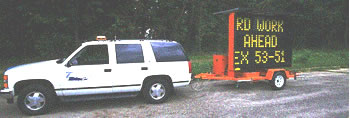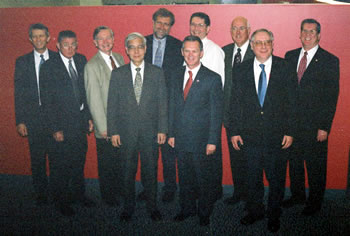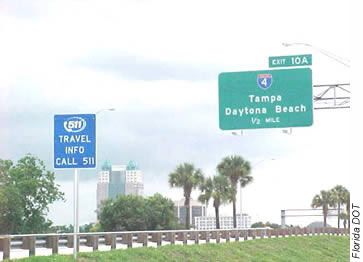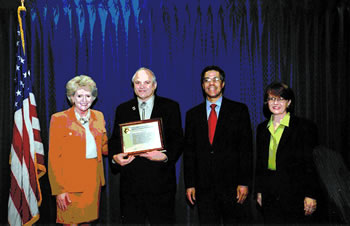U.S. Department of Transportation
Federal Highway Administration
1200 New Jersey Avenue, SE
Washington, DC 20590
202-366-4000
Federal Highway Administration Research and Technology
Coordinating, Developing, and Delivering Highway Transportation Innovations
|
Research & Technology Transporter This newsletter is an archived publication and may contain dated technical, contact, and link information. |
|
| Publication Number: N/A Date: May 2003 |
Publication Date: May 2003
|
From 1980 to 2000, vehicle travel on the national highway system increased by 80 percent, while lane miles only increased by 2.4 percent. An Oak Ridge National Laboratory report indicates that 24 percent of all non-recurring congestion is caused by work zones. In 2001, work zone fatalities reached a high of 1,079, with 85 percent of the fatalities being motorists. And in a recent survey, the American public cited work zones as second only to poor traffic flow in causing traveler dissatisfaction.
Unfortunately, much of the Nation's transportation infrastructure is approaching the end of its service life and a transportation improvement program will necessitate an increase in preservation, rehabilitation, and maintenance-and work zones are necessary to maintain and upgrade the aging highway infrastructure. The need for more work zones and heavier traffic volumes likely will affect the impacts of these work zones. Combined, these factors point to a transportation system that will face greater congestion levels, greater customer frustrations, and the potential for further work zone injuries and fatalities.
Right now, improvements related to roadway repairs and work zones might include using more durable paving materials, making repairs during non-rush hours, and reducing repair times. Additionally, State DOTs are applying pressure to contractors to expedite construction and minimize disruption.
In March 2003, representatives from the Federal Highway Administration (FHWA), the American Association of State Highway and Transportation Officials, the Associated General Contractors of America, and others met in Seattle, WA, to discuss new specifications for traffic control that would encourage contractors specializing in building roadways and transportation infrastructure to include traffic management, traffic control planning, and implementation criteria in their construction planning, scheduling, and execution of work. Contractors were involved in the discussions because they perform the roadway work and ultimately schedule the day-to-day activities on the road during construction. By involving contractors in traffic control planning, scheduling, and implementations of work zones, the meeting participants expect to improve safety for both workers and drivers while enhancing the mobility of the traveling public.
At the meeting, participants focused on developing a broad set of requirements to be included in the new "draft" performance-based specification guide scheduled for completion in late 2003. For example, the specifications will increase a contractor's responsibility for minimizing the duration of work zones and reducing subsequent work zone delay and congestion. By addressing traffic management early in the process prior to the actual start of roadway construction, during the construction planning and scheduling stages, the viewpoint is that contractors can help tackle the traffic problem throughout the project and better meet design, traffic, and safety expectations.
This WZTS Performance-based Specification Team also discussed incorporating measurable standards or criteria into the new specifications to evaluate contractor performance at managing traffic in work zones. Measures of performance could include such items as vehicle travel (speed, delay, travel time, Queue length) and incident response times in work zones, the duration of work or critical portions of the work (time in the roadway), the level of information distributed to the public about the work zone, and overall work zone safety.
In addition, the performance specifications will encourage contractors to use new technologies in traffic management, including visual scanners, software applications such as QuickZone-an analytic software program used for estimating work zone delay-and intelligent transportation systems that model and monitor performance and enable workers to detect changes in traffic flow, density, and delay while activity is occurring within a work zone.
The payback? Reductions in delay and congestion from work activities, improvements in coordination of contractor scheduling and operations on the road, and performance incentives paid for contractor improvements in planning and executing work zone operations.
Jim Sorenson 202-366-1333 james.sorenson@fhwa.dot.gov
 |
| Intelligent transportation system technologies, such as the variable message sign shown here, can help improve traffic flow through work zones. |
Since September 11, 2001, transportation engineers have become responsible for ensuring that bridges and tunnels not only withstand natural hazards such as the weather and the effects of everyday use, but also are strong enough to endure security threats.
To help engineers and other professionals within State departments of transportation (DOTs) meet this challenge, the Federal Highway Administration's (FHWA) Office of Bridge Technology, the U.S. Department of Homeland Security (DHS), the American Association of State Highway and Transportation Officials (AASHTO), and other transportation organizations recently sponsored several short-term initiatives to assess vulnerabilities and implement strategies to improve the security of bridges, tunnels, and other transportation infrastructure.
For the first initiative, FHWA and the Engineer Research and Development Center operated by the U.S. Army Corps of Engineers (USACE) held three workshops in spring 2003 on the vulnerability of bridges and tunnels. Designed for engineers from FHWA, State DOTs, and the private sector, the workshops focused on a wide range of security issues, including the susceptibility of bridges and tunnels to explosive attacks, methods to mitigate weaknesses, and structural response to blast-induced loadings versus typical loads caused by trucks and earthquakes. The workshops also highlighted tools that transportation engineers can use to evaluate bridges and tunnels, including a new AASHTO manual-A Guide to Highway Vulnerability Assessment for Critical Asset Identification and Protection-that provides State DOTs with a model for assessing the vulnerability of physical assets, developing potential countermeasures, estimating costs, prioritizing assets, and improving overall operational planning.
In the second initiative, FHWA formed teams of engineers to help State DOTs assess risks, develop programs, and apply state-of-the-art practices for improving the security of bridges and tunnels. The teams will help State DOTs identify critical structures in the transportation network that could be vulnerable to attacks or could be important in the event of an attack, such as bridges, tunnels, traffic control centers, maintenance facilities, and highway interchanges. FHWA's teams will provide assistance to the States on a structure-by-structure basis, at the city or regional level, or on a systems basis, such as locations where interstates link together. In cooperation with DHS, the teams also will work directly with States and localities to apply countermeasures. In addition, the teams will work with USACE to explore new ways to protect the Nation's highway infrastructure.
For the third initiative, in fall 2002, FHWA joined with AASHTO's Security Task Force and the National Cooperative Highway Research Program (NCHRP) to establish a blue ribbon panel of experts on bridge and tunnel security. The panel, comprised of 11 appointed individuals from industry, academia, and government, will develop recommendations on actions that bridge and tunnel owners and operators and members of FHWA, State agencies, and other Federal agencies can take to improve security of critical bridges and tunnels. The panel will publish its final recommendations in the summer of 2003 and will develop a long-term agenda focused on measures to strengthen transportation infrastructure against future attacks. FHWA will conduct the research necessary to develop the measures in cooperation with DHS, USACE, NCHRP, AASHTO, and several universities. In addition, the long-term agenda will focus on the transfer of security technologies between transportation agencies and organizations.
Finally, the Office of Bridge Technology will support DHS efforts by working with AASHTO to develop a uniform process for assessing the vulnerability of highway systems and identifying and prioritizing critical highway assets.
Steve Ernst 202-366-4619 steve.ernst@fhwa.dot.gov
 |
| Members of the AASHTO/FHWA blue ribbon panel. From left to right: Jeremy Isenberg, James E. Roberts, John W. Fisher, Man-Chung Tang, Frieder Seible, Dwight A. Beranek (front), Joseph M. Englot (back row), Kenneth E. Stinson, John M. Kulicki, Henry Hungerbeeler, Kary Witt (not shown). |
Pam Mathis was the ICF writer for this article.
In 2001, an estimated 84,000 people were injured in crashes caused by drivers who failed to stop at red lights. To help prevent these crashes, a growing number of cities and counties are installing red-light cameras. Although implementation of this technology is widespread, little guidance is available on proven, effective, and comprehensive procedures that traffic engineers, law enforcement officials, and other managers at State and local transportation agencies can follow to implement successful programs.
In March 2003, the Federal Highway Administration (FHWA) and the National Highway Traffic Safety Administration (NHTSA) published guidance for State and local agencies on the essential steps in developing an effective program for installing and maintaining red-light cameras. The FHWA and NHTSA Guidance for using Red Light Cameras publication provides information to promote consistency and proper implementation and operation of the technology.
Red light cameras are identified as photo-detection systems composed of a vehicle detector; a microprocessor; and a wet film, digital, or video camera attached to a 4.5-meter (15-foot) pole that take photographs of cars as they enter an intersection. When a driver enters after the light turns red, the microprocessor records the date, time of day, vehicle speed, and the time elapsed from the beginning of the red signal until the camera takes a photo of the vehicle. Later, local enforcement agencies use the data to identify red-light violators.
According to the guidance, the initial step is for agencies to perform a systematic analysis of data on crashes, red-light violations, and input from the public to identify locations where red-light running is contributing to crashes. The second step is to determine the right strategy to prevent red-light running.
If red-light cameras are deemed to be the appropriate solution, the guidance suggests that agencies consider developing a program for the implementation of red-light cameras by establishing an oversight committee, determining program objectives, and identifying legal requirements. The guidance provides information on the necessary components of the program, including a public education and awareness campaign focused on changing driver behavior at red lights, an engineering plan that includes information on the placement and installation of camera equipment, procedures for the operation and maintenance of the cameras, and a method for issuing citations to motorists who run red lights. Once the cameras are in use, the guidance provides details on developing an ongoing education campaign and assessing the performance of the camera system.
For more information or to download a copy of the guidance, visit http://safety.fhwa.dot.gov/intersections/rlc_guide/index.htm
Hari Kalla 202-366-5915 hari.kalla@fhwa.dot.gov
  |
| These photos of a vehicle entering an intersection after the onset of red and then slamming into the side of another vehicle brings to life the stark reality of red light running. |
Because the demands for performance, economy, and durability of our Nation's bridges continue to increase, researchers in the structures laboratory at the Federal Highway Administration's (FHWA) Turner-Fairbank Highway Research Center continue working to improve the materials and methods used by bridge engineers. Heading up this research is William Wright, who recently earned FHWA's 2002 award for Engineer of the Year and received the agency's Engineering Excellence Award for outstanding professional achievement. The National Society of Professional Engineers also recognized Wright's professional achievements by honoring him and several other distinguished engineers who work for the Federal government.
Since joining FHWA in 1988, Wright has become one of FHWA's key technical experts on the design, fabrication, construction, and inspection of structural steel bridges. His work in the FHWA Structures Lab has focused on the development of data for high-performance steel (HPS) and full-scale testing of curved steel girder bridges. He has also performed valuable field work, such as leading a forensic investigation into the failure of the Hoan Bridge in Milwaukee, WI, where he helped identify the cause of its brittle fracture and then drafted technical guidance that addresses similar problems on other spans.
Wright also directs a national pooled fund project to conduct full-scale testing and comprehensive analytical modeling of highway bridges constructed from curved steel girders. This work has led to the unification of design methodologies for curved and straight girder bridges in the forthcoming 3rd edition of the American Association of State Highway and Transportation Officials load resistance factor design (LRFD) code for steel bridges. Wright's findings from the curved girder project played a significant role in the development of strength equations and new specifications that will help maximize the efficiency and capacity of curved structures made from steel.
Working with other engineers at Structures Laboratory, Wright also is researching ways to improve fracture toughness specifications for HPS. These efforts provide hope for eliminating concerns regarding critical fracture in the future by using the inherent toughness of HPS to greater advantage in design.
Wright received a bachelor's degree in civil engineering and a master's in structural engineering from the University of Maryland, and his Ph.D. in structural engineering from Lehigh University in June 2003. Wright serves on several national technical committees, including the steel bridge committee for the Transportation Research Board and the fatigue and fracture committee for the American Society of Civil Engineers.
Bob Kogler
Building and maintaining the transportation system of the future will require a new generation of transportation professionals. Since 1993, the Federal Highway Administration's (FHWA) National Summer Transportation Institute (NSTI) has helped prepare this new generation by introducing middle- and high-school students to transportation-related careers and the skills they need to pursue work in the transportation industry. On May 13, 2003, NSTI celebrated its 10th anniversary with a ceremony in Washington, DC.
FHWA Administrator Mary E. Peters delivered the event's opening remarks, emphasizing the importance of NSTI in increasing awareness about transportation-related careers. Several other transportation officials from around the Nation also spoke, including Secretary of the Kentucky Transportation Cabinet James Codell and FHWA's Virginia Division Administrator Robert Fonseca. Former Secretary of Transportation Rodney Slater and Congressman James Clyburn from South Carolina provided closing remarks.
During the ceremony, FHWA announced its strategic goals for the future of NSTI. Over the next 5 years, the agency plans to have 10,000 students participate in the program. In addition, the agency would like to establish an NSTI program in every State.
FHWA presented awards to South Carolina State University, the South Carolina Department of Transportation, and FHWA's South Carolina Division for helping to establish the NSTI program. In addition, a former NSTI student-currently a senior financial analyst for Union Pacific Railroad-spoke about the success that she has found due, in part, to the skills she learned in the program in 1994.
Each summer, NSTI holds several 4-week sessions on 44 college and university campuses in 26 States. In the past 10 years, nearly 5,000 students have participated in the program, exploring the transportation industry through a variety of intermodal transportation demonstrations, field trips, and math, science, and technology enrichment activities.
Gary Strasburg
Photo 1: WAITING FOR PHOTOS FROM CONTACT
Caption:
Photo credit:
Florida-known for sunshine and citrus-soon could be known as well for its intelligent transportation systems (ITS). In April 2003, the Federal Highway Administration (FHWA) announced a partnership with the Florida Department of Transportation (FDOT) to deploy and test ITS technologies for evaluating the benefits of collecting surface transportation data. FDOT and its partners plan to deploy ITS technologies throughout the State to demonstrate how these systems can improve the safety, security, and mobility of motorists on the Nation's roadways and users of public transportation networks. The project will be conducted over the next 4 years and will have three key components: evaluating ITS in metropolitan areas, on the State's highway network, and in hurricane-prone coastal areas.
Across the intrastate highway network, FDOT will deploy a new system to report information about roadway events, incidents, construction, and other capacity restrictions. Recipients will include public transportation agencies and private-sector providers of traffic information, such as companies that prepare traffic updates for radio and television stations. The system also will report weather information collected using new road weather sensors designed to detect heavy fog, high winds, or flooding conditions. This data will help agencies and organizations develop forecasts by road segment. In addition, the reporting system will provide information about current travel times and weather conditions by road segment to Florida's 5-1-1 telephone service. Drivers in Florida can call the 5-1-1 telephone service-a national telephone number that drivers can call to access travel information-to hear local traffic and weather updates.
In Brevard County and the City of Jacksonville, which are located on the hurricane-prone eastern coast of Florida, FDOT will use license plate readers at key intersections to collect travel times along segments of parallel arterials. This information will offer transportation operators a complete picture of traffic flow. The operators will use the data to improve evacuations during hurricanes and other events that could result in capacity restrictions. FDOT also will deploy innovative technologies to monitor the security of critical roadway infrastructure along the routes that provide access to the Kennedy Space Center and to Naval Air Station Jacksonville.
In Orlando, the project's metropolitan focus, vehicles already equipped with toll tags will serve as probes, providing FDOT with travel-time information about the entire freeway and arterial network. FDOT also will install automatic vehicle-location devices in the city's fixed-route transit and paratransit (transportation services for people with disabilities who cannot use the regular fixed route services) vehicles. The data collected by the devices, such as vehicle departure and travel times, will help improve the management of transit fleets and will provide riders with information on transit schedules and arrival times.
The ITS deployment will last for approximately 2 years. After that time, FHWA and FDOT will conduct an operational evaluation to examine and document how collecting real-time information can help improve safety, congestion management, and incident response; enhance travel time reliability; and lead to improved overall operational performance of the surface transportation system.
FHWA and FDOT and its partners are all providing financial support for the project, officially known as the Surface Transportation Security and Reliability Information System Model Deployment. FHWA will contribute Federal ITS funds to Florida, and FDOT will provide matching funds from State, local, and private-sector sources.
Toni Wilbur 202-493-3269 toni.wilbur@fhwa.dot.gov
 |
| Photo of the Florida Highway with its 5-1-1 telephone service sign. |
Since 1995, the Federal Highway Administration (FHWA) has conducted these biennial awards to honor agencies and organizations that develop transportation projects or programs that go beyond environmental compliance. Each winner must demonstrate that they achieved environmental excellence by incorporating environmental stewardship into the planning and development process. In addition, each project or program must be developed using FHWA funds.
As part of the Earth Day celebration on April 22, 2003, FHWA acknowledged the efforts of several environmental leaders at the 2003 Environmental Excellence Awards. FHWA honored 12 winners in 11 categories for the following projects:
State and Federal officials in Vermont developed a model agreement that streamlined the review process for determining the impacts of transportation projects on historic and archeological resources. (Environmental Streamlining)
The Paris Lexington Road project, in Kentucky, entailed Cabinet the redesign of a 19-kilometer (12-mile) stretch of highway, fitting the new road to the land; avoiding sensitive areas; and making the road safer, more attractive, and visually interesting. (Cultural and Historical Resources)
The Colorado Department of Transportation's (DOT) initiative to enact easements and management agreements that will conserve 6,070 to 20,200 hectares (15,000 to 50,000 acres) of the State's shortgrass prairie to mitigate for environmental impacts from proposed transportation projects. (Ecosystems)
Federal, State, and county partners in Oregon voluntarily established a program to set aside 10 percent of the Oregon Forest Highway Fund for improving signage, interpretive sites, trailheads, and roadside facilities along the State's forested highways. (Scenic Byways)
The Maryland State Highway Administration placed all stormwater management activities under a single program charged with locating, inspecting, evaluating, remediating, and enhancing all stormwater management facilities. They also designed a template to address prevention of stormwater pollution systematically. (Wetlands and Water Quality)
The Washington State DOT developed a roadside classification plan that serves as a framework for providing consistent, cost-effective, and proactive management of roadsides throughout the State. They also developed a roadside manual, which outlines methods for implementing the practices in the plan. (Roadside Resource Management)
Broward County, FL, developed a long-range transportation plan that includes pedestrian improvements such as overpasses over busy roadways; improved access to transit facilities and schools, parks, and similar activity centers; and a bicycle plan that complements other Broward County plans. (Nonmotorized Transportation)
Iowa DOT, Iowa State University, and the Trees Forever organization developed the Living Roadways program, which encourages creative and strategic thinking about landscape improvements along transportation corridors and provides funds for the implementation of locally led enhancement projects. (Livable Communities)
The City of Los Angeles created a public-private partnership to improve street preservation through the use of premixed, rubberized slurry seals made from recycled tires. (Recycling)
The Aesthetic Initiative Measurement System (AIMS) tested and developed instruments the Minnesota DOT can use to understand how travelers perceive the visual quality of the State's highway corridor treatments and landscapes. (Environmental Research)
The North Carolina DOT and the North Carolina Department of Environment and Natural Resources signed a memorandum of understanding between the two agencies outlining their environmental stewardship goals. (Environmental Leadership-Group Award)
Wes Goff provided 38 years of service to the Colorado DOT, where he helped minimize environmental impacts of transportation projects and worked to restore and protect sensitive habitats while building the State's transportation network. (Environmental Leadership-Individual Award)
For more information about the awards program and the 2003 winners, visit www.fhwa.dot.gov/environment/eea2003/awards/index.htm.
Patricia Cazenas 202-366-4085 patricia.cazenas@fhwa.dot.gov
 |
| Wes Goff, the winner of the Environmental Leadership Award to an individual, poses for a photo. Left to Right: Mary Peters, FHWA Administrator; Wes Goff, Colorado Department of Transportation; Dr. Dale Jones, legislative director for Colorado Congressman Bob Beauprez; Cindy Burbank, Associate Administrator for Planning, Environment, and Realty. |
Keri Funderburg was the ICF writer for this article.